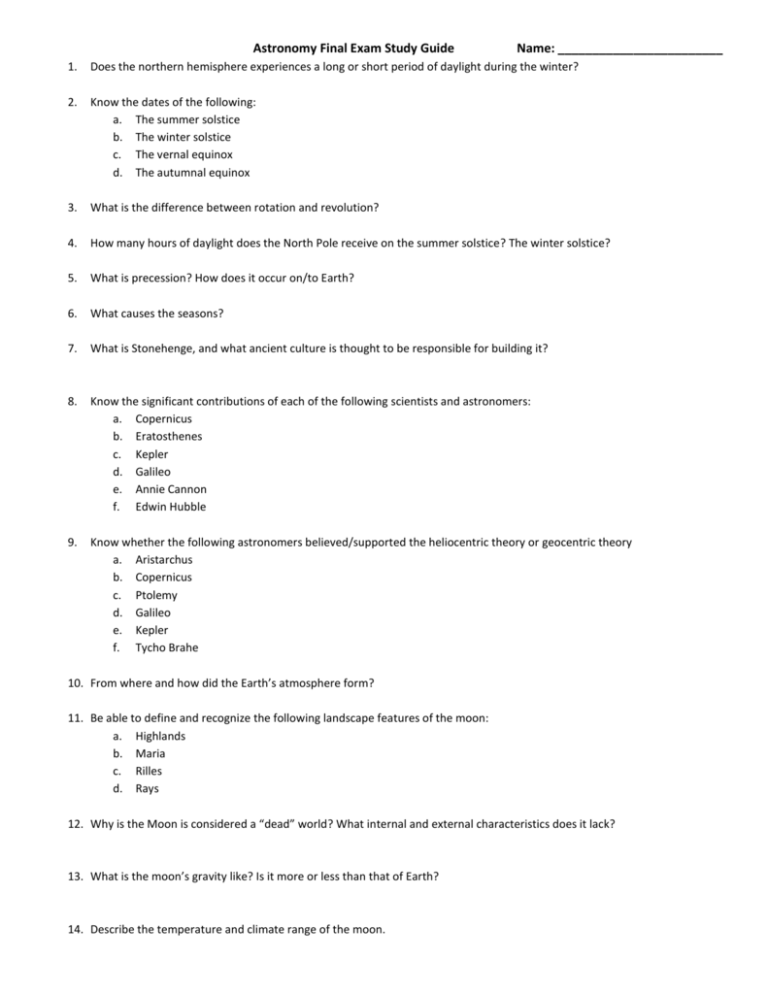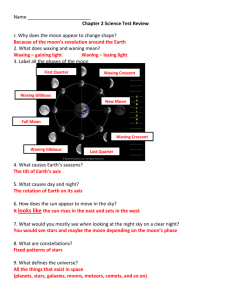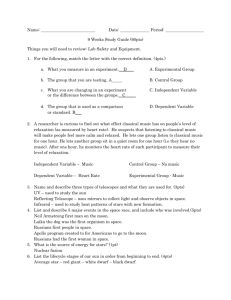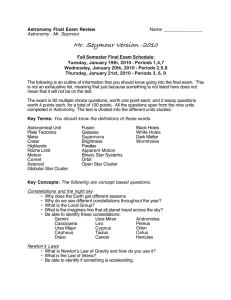Final Exam Study Guide
advertisement

Astronomy Final Exam Study Guide Name: ________________________ 1. Does the northern hemisphere experiences a long or short period of daylight during the winter? 2. Know the dates of the following: a. The summer solstice b. The winter solstice c. The vernal equinox d. The autumnal equinox 3. What is the difference between rotation and revolution? 4. How many hours of daylight does the North Pole receive on the summer solstice? The winter solstice? 5. What is precession? How does it occur on/to Earth? 6. What causes the seasons? 7. What is Stonehenge, and what ancient culture is thought to be responsible for building it? 8. Know the significant contributions of each of the following scientists and astronomers: a. Copernicus b. Eratosthenes c. Kepler d. Galileo e. Annie Cannon f. Edwin Hubble 9. Know whether the following astronomers believed/supported the heliocentric theory or geocentric theory a. Aristarchus b. Copernicus c. Ptolemy d. Galileo e. Kepler f. Tycho Brahe 10. From where and how did the Earth’s atmosphere form? 11. Be able to define and recognize the following landscape features of the moon: a. Highlands b. Maria c. Rilles d. Rays 12. Why is the Moon is considered a “dead” world? What internal and external characteristics does it lack? 13. What is the moon’s gravity like? Is it more or less than that of Earth? 14. Describe the temperature and climate range of the moon. 15. Describe how the moon rotates around Earth. 16. How and from where did the moon form? 17. Who was the first man to walk on the moon? 18. What is tidal braking, and what does it cause? 19. Know the difference between spring tides and neap tides, and be able to describe how the moon, sun, and Earth are aligned during each. 20. How often do low tides and high tides occur, and what causes each? 21. When does a lunar eclipse occur? A solar eclipse? How or when does each occur? 22. Be familiar with the phases of the moon. Be able to relate the moon phases to the occurrence of spring tides, neap tides, and lunar eclipses. 23. Know the eight planets of the solar system and their order from the sun. 24. Be familiar with the names and characteristics of the terrestrial planets. 25. Be familiar with the names and characteristics of the Gas Giants. 26. What is the hottest planet in our solar system, and why? 27. Where do asteroids come from? 28. Where do comets come from? 29. What is the name of the hypothesis of how our solar system formed? 30. The following terms and phrases are the six steps in the solar nebula hypothesis. Place these in order from first to last, and be familiar with what happens in each step. Condensation Formation of planetesimals Accretion Formation of planetary atmospheres Formation of planets Interstellar cloud collapses into interstellar disk 31. Why are the planets made up of different elements? 32. Be familiar with the following vocabulary relating to the electromagnetic spectrum, and know how those terms apply on both ends of the spectrum a. Wavelength b. Frequency c. Energy 33. List the order of the electromagnetic spectrum from lowest to highest energy. 34. What does the ozone layer absorb to protect Earth? 35. Be familiar with the following telescope vocabulary. a. Aperture b. Focal point c. Primary Mirror d. Objective lens e. Eyepiece lens 36. An instrument used to observe visible light and split it up into its component colors is known as a…? 37. An individual particle or bundle of light is called a 38. What is a light-year? 39. About how long does it take light from the Sun to reach the Earth? 40. When we built camera obscuras in class, you were able to use them to see and visualize simple images. How did the images appear to you inside the box? For example, if you were looking at a tree, how would the tree look once the light goes inside the camera box? 41. What color are the hottest stars? 42. Specific elements absorb specific wavelengths of visible light. This is called an element’s absorption lines. When looking at far away stars, we can use these absorption lines to determine what characteristics about a star? 43. What are the two most abundant elements in the universe? 44. What is a stellar nebula? How is it different from a protostar? 45. What is the name of the process by which stars turn hydrogen into helium and create energy? 46. There are three end-stage forms of a star: white dwarves, neutron stars, and black holes. Under what circumstances will these types of stars form? What type of end-stage star will our sun become? 47. When a massive star explodes as a supernova, what two types of end-stage stars can form? 48. Be familiar with how to use the Hertzsprung-Russell diagram above to classify stars according to temperature, magnitude, and/or luminosity. 49. Use the terms red giant, protostar, white dwarf, planetary nebula, and main sequence star to describe the evolutionary sequence of a star. 50. What is a neutron star? 51. What is a pulsar? 52. What object is found at the center of every galaxy? 53. Why are black holes black? 54. What is the estimated diameter of the Milky Way’s disk? 55. What are the three main types of galaxies? 56. How did the Milky Way get its name? 57. The Big Bang Theory suggests that all of the matter in the universe arose from a single explosion of matter many billions of years ago, and we have evidence today to suggest that the universe is STILL expanding. As light leaves an object that is moving away from us, the wavelength of light appears to be longer. This phenomenon is also known as 58. How old is the universe? 59. How old is our solar system? How old is Earth? 60. What is the name of the galaxy that is nearest to our own? 61. If a galaxy is moving further and further away from the Earth, will we observe a greater redshift or blueshift in the light coming from this galaxy? 62. What is dark matter? How do we know it exists? 63. How do spiral and elliptical galaxies differ? 64. How do we study the Universe as it existed a long time ago? 65. How do we measure the age of the universe? 66. What is a constellation? 67. Why is Polaris also called the North Star? 68. Why are we not able to see some constellations during certain months of the year? 69. What is the zenith? 70. Know the names of the following stars: a. The closest star to Earth b. The brightest star in the night sky c. The North Star 71. There are five circumpolar constellations. What are they? 72. According to the International Astronomical Union (IAU), the sky is divided into how many official constellations? Be familiar with the appearance of the following five constellations: Libra, Pisces, Cassiopeia, Draco, Ursa Minor








